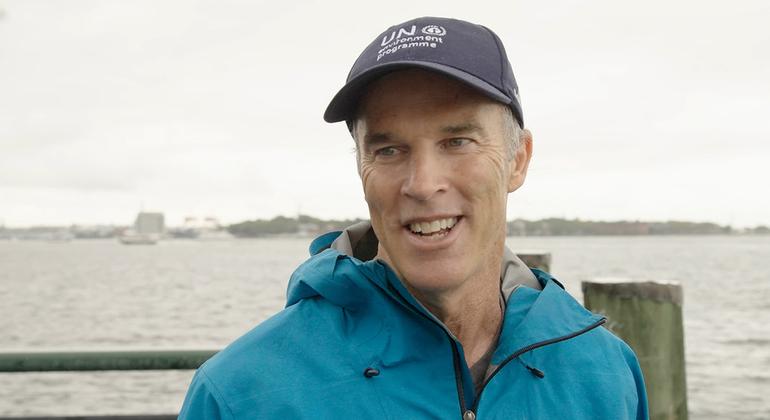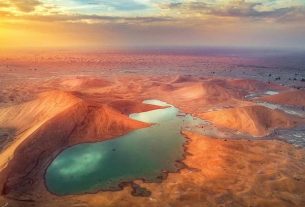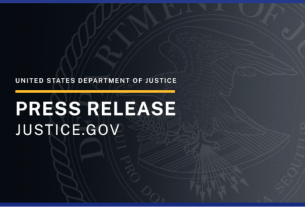The UN Environment Programme’s (UNEP) official Patron of the Oceans, Mr. Pugh explained that he’d undertaken the marathon swim ending at the tip of Manhattan, to emphasise the urgent need to protect the world’s waterways ahead of the UN’s landmark High Seas Treaty and Climate Ambition Summit next week.
Sporting his UNEP swim cap, Mr. Pugh lifted himself out of New York Harbor, just a short walk from the World Trade Center, to a crowd of supporters and curious onlookers.
Dream swim
The 53-year-old British-South African began his 32-day journey in a small lake just south of the idyllic Adirondack village, Lake Placid. For over a month, he swam down the entire length of the river, occasionally covering over 20 km in a single day.
“I’ve been dreaming about this swim for many years, but it’s been worth the wait. For the past month I’ve got to know the Hudson River really intimately, and it feels like I’ve made a lifelong friend with this river,” said Mr. Pugh.
He described being in awe of the extraordinary biodiversity he had seen, which helped him push through the physical pain of the swim.
It also stiffened his resolve to keep advocating for damaged marine ecosystems across the globe.
Lewis Pugh, UNEP Patron of the Ocean, swims into the New York Harbor
“The bald eagles, the vultures, the beavers, the black bears. Then swimming into Albany and turning onto my back to do a little backstroke to open up the chest and watching an osprey slowly following me down the river…It’s something you will never forget,” he said.
“But we must also never forget the history of the Hudson. Yes, more needs to be done and we must continue to be vigilant. But the Hudson gives me hope. I hope it gives hope to people around the world that one day, their rivers can also be saved.”
Profound message
Mr. Pugh chose the Hudson to highlight successful efforts to clean the river in recent decades and encourage other countries to adopt similar efforts in some of the world’s most polluted waterways.
“I’m so delighted we have been able to do this swim successfully and I think this river is emblematic of rivers all over the world,” said Mr. Pugh.
“Water is essential for life on earth. If we are going to have healthy oceans, we also have to have healthy rivers; they are the arteries of our planet.”
Dirty history
Just 150 years ago, the Hudson River was one of the most productive ecosystems in the world. Populations of sturgeon, river herring, and blue crab used the river as a corridor from the Atlantic Ocean to spawning grounds upriver.
In the early 20th century, however, population growth and industrialization devastated the international waterway. Chemical waste dumping, overfishing, and habitat fragmentation threatened the biodiversity of the river and the communities that depended on it.
Efforts to clean up the Hudson and its many tributaries over the past 50 years, however, have begun to bear fruit. In 1972 the United States passed the Clean Water Act, banning companies from dumping chemical waste into the nation’s navigable waterways.
Bans on commercial fishing were introduced in 1976 and extended in 1985. In 2002, officials began dredging riverbed sediment laden with polychlorinated biphenyls (PCB) which had contaminated a 320 km stretch of the river.
UN coordination role

Lewis Pugh, UNEP Patron of the Ocean, immediately after his 517 km swim down the Hudson river.
According to UNEP, water, inequalities, and the environment are closely linked.
Billions of people worldwide currently live without access to safely managed drinking water and sanitation services, even though access to both has been defined as a human right.
This has encouraged a renewed willingness among UN Member States to finally address damage to the world’s waterways ahead of the Climate Ambition Summit.
Building on the legacy of the UN Convention on the Law of the Sea, the High Seas Treaty aims to ensure the conservation and sustainable use of marine resources beyond national maritime boundaries.
It provides a framework for increased cooperation between Member States and other international stakeholders to promote the sustainable development of the ocean and its resources.
Its implementation will make critical contributions to the goals and targets of the 2030 Agenda for Sustainable Development.
‘Huge privilege’
“It’s a huge privilege to be able to represent the UN, and I feel passionate about countries working together to solve environmental issues. Nations will be able to come to the UN and be able to ratify the High Seas treaty,” Mr. Pugh told UN News, shortly after emerging from the water.
“It’s the last piece of the world that finally needs protecting. I’m really excited to be there next week for this really historic moment.”
The treaty provides, for the first time, an international legal framework for the assessment of the cumulative impacts of climate change in areas beyond national maritime boundaries.
It will also boost international cooperation to level the playing field for all Member States to benefit from healthy marine ecosystems.
International conservation boost
“This treaty is important because, up until now, the conservation efforts of marine ecosystems were restricted to territorial waters of individual countries,” Jamil Ahmad, UNEP New York Director of Intergovernmental Affairs told UN News.
“Now, with the High Seas Treaty, the oceans at large will come under the jurisdiction of environmental governance, and we will have cooperation, partnerships, and collaborations of countries and regions on a global level to protect global ecosystems.”
The High Seas Treaty will be open for signature at United Nations Headquarters in New York for two years from 20 September 2023, the day after the 2023 Sustainable Development Goal Summit. It will enter into force after ratification by 60 States.



